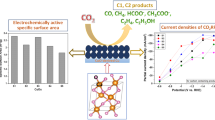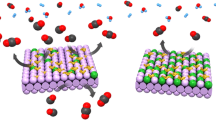Abstract
Carbon monoxide oxidation activities over Cu, Cu2O, and CuO were studied to seek insight into the role of the copper species in the oxidation reaction. The activity of copper oxide species can be elucidated in terms of species transformation and change in the number of surface lattice oxygen ions. The propensity of Cu2O toward valence variations and thus its ability to seize or release surface lattice oxygen more readily enables Cu2O to exhibit higher activities than the other two copper species. The non-stoichiometric metastable copper oxide species formed during reduction are very active in the course of CO oxidation because of its excellent ability to transport surface lattice oxygen. Consequently, the metastable cluster of CuO is more active than CuO, and the activity will be significantly enhanced when non-stoichiometric copper oxides are formed. In addition, the light-off behaviors were observed over both Cu and Cu2O powders. CO oxidation over metallic Cu powders was lighted-off because of a synergistic effect of temperature rises due to heat generation from Cu oxidation as well as CO oxidation over the partially oxidized copper species.
Similar content being viewed by others
References
J. T. Kummer, Prog. Energy Combust. Sci. 6 (1980) 177.
T. J. Huang and T.-C. Yu, Appl. Catal. 71 (1991) 275.
M. O'Keefie and W. J. Moore, J. Chem. Phys. 36 (1962) 3009.
G. G. Jernigan and G. A. Somorjai, J. Catal. 147 (1994) 567.
V. A. Sadykov and S. F. Tikhov, J. Catal. 165 (1997) 279.
K. Nagase, Y. Zheng, Y. Kodama and J. Kakuta, J. Catal. 187 (1999) 123.
E. D. Pierron, J. A. Rashkin and J. F. Roth, J. Catal. 9 (1967) 38.
F. Severino and J. Laine, Ind. Eng. Chem. Prod. Res. Dev. 22 (1983) 396.
K. I. Choi and M. A. Vannice, J. Catal. 131 (1991) 22.
C. A. Leon y Leon and M. A. Vannice, Appl. Catal. 69 (1991) 269.
M. Lo Jacono, A. Cimino and M. Inversi, J. Catal. 76 (1982) 320.
A. Yanase and H. Komiyama, Surf. Sci. 248 (1991) 11.
G. K. Boreskov, in: Catalysis: Science and Technology, Vol. 3, eds. J. R. Anderson and M. Boudart (Springer-Verlag, Berlin, 1982) p. 40.
A. Bielanski and J. Haber, Oxygen in Catalysis (Dekker, New York, 1991) p. 244.
G. I. Golodets, Heterogeneous Catalytic Reactions Involving Molecular Oxygen (Elsevier, Amsterdam, 1983) p. 280.
Author information
Authors and Affiliations
Corresponding author
Rights and permissions
About this article
Cite this article
Huang, TJ., Tsai, DH. CO Oxidation Behavior of Copper and Copper Oxides. Catalysis Letters 87, 173–178 (2003). https://doi.org/10.1023/A:1023495223738
Issue Date:
DOI: https://doi.org/10.1023/A:1023495223738




